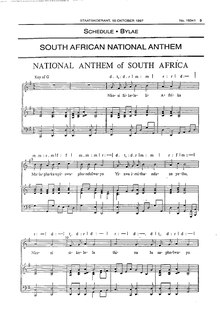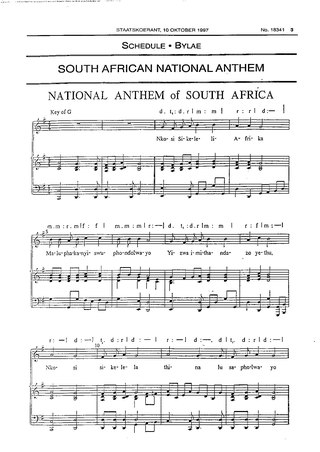National anthem of South Africa
From Wikipedia, the free encyclopedia
The national anthem of South Africa was adopted in 1997 and is a hybrid song combining extracts of the 19th century Xhosa hymn "Nkosi Sikelel' iAfrika" (English: "God Bless Africa", lit. '"Lord Bless Africa"') and the Afrikaans song that was used as the South African national anthem during the apartheid era, "Die Stem van Suid-Afrika" (English: "The Voice of South Africa"), with new English lyrics.[1]
 The South African national anthem as it appears specified in the South African Government Gazette | |
National anthem of South Africa | |
| Also known as | "Nkosi Sikelel' iAfrika" (first segment) (English: "Lord Bless Africa") "Die Stem van Suid-Afrika" (second segment) (English: "The Call of South Africa") |
|---|---|
| Lyrics | Enoch Sontonga, 1897 Cornelis Jacobus Langenhoven, 1918 Jeanne Zaidel-Rudolph, 1995 |
| Music | Enoch Sontonga, 1897 Marthinus Lourens de Villiers, 1921 (arranged by Mzilikazi Khumalo and Jeanne Zaidel-Rudolph, 1995) |
| Adopted | 1997 |
| Preceded by | "Die Stem van Suid-Afrika" and "Nkosi Sikelel' iAfrika" |
| Audio sample | |
U.S. Navy Band instrumental version | |
| Zulu | iNgoma-Yesizwe yaseNingizimu Afrika |
|---|---|
| Xhosa | uMhobe weSizwe waseMzantsi Afrika |
| Afrikaans | Volkslied van Suid-Afrika |
| Sepedi | Koša ya Naga ya Afrika Borwa |
| Swazi | Umlandvo we Ngoma yeSive yase Ningizimu Afrika |
| Sesotho | Pina ya Naha ya Afrika Borwa |
| Setswana | Pina ya Bosetšhaba ya Afrika Borwa |
| Xitsonga | Matimu ya Risimu ra Rixaka ra Afrika |
| Venda | Ḓivhazwakale ya Limbo lwa Lushaka lwa Afrika Tshipembe |
| Southern Ndebele | Zimu Busisa i-Afrika |
The anthem is often referred to by its incipit of "Nkosi Sikelel' iAfrika", but this has never been its official title, which is simply "National Anthem of South Africa".
The committee responsible for this new composition included Anna Bender, Elize Botha, Richard Cock, Dolf Havemann (Secretary), Mzilikazi Khumalo (chairman), Masizi Kunene, John Lenake, Fatima Meer, Khabi Mngoma, Wally Serote, Johan de Villiers, and Jeanne Zaidel-Rudolph.[2]
Structure
The lyrics employ the five most widely spoken of South Africa's twelve official languages – Xhosa (first stanza, first two lines), Zulu (first stanza, last two lines), Sesotho (second stanza), Afrikaans (third stanza), and English (final stanza). The lyrics are sung in these languages regardless of the native language of the singer. The first half was arranged by Mzilikazi Khumalo[3] and the latter half of the song was arranged by Jeanne Zaidel-Rudolph, who also wrote the final verse.[3][4] The fact that it shifts (modulates) and ends in a different key (from G major to D major) a feature that it shares with the Italian, Spanish, and the Philippine national anthems,[5] makes it compositionally unusual.
History
Summarize
Perspective
Background
From the late 1940s to the early 1990s, South Africa was governed by a system known as apartheid, a widely condemned system of institutionalized racial segregation and discrimination that was based on white supremacy and the repression of the black majority for the benefit of the politically and economically dominant Afrikaner minority and other whites. During this period, South Africa's national anthem was "Die Stem van Suid-Afrika", also known as "Die Stem", an Afrikaans-language song that chronicled the Voortrekkers and the Great Trek. "Die Stem" is a poem written by C. J. Langenhoven in 1918 and was set to music by Marthinus Lourens de Villiers in 1921.[6] "Die Stem" (English: "The voice of South Africa") was the co-national anthem[7] with "God Save the King"[a] between 1938 and 1957, when it became the sole national anthem until 1994. "Die Stem van Suid-Afrika" was composed of eight stanzas: the original four in Afrikaans and four in English - a translation of the Afrikaans with a few modifications. It was seldom sung in its entirety; usually, the first stanza was the most widely known and sung sometimes followed by the last stanza.
When apartheid came to an end in the early 1990s, the future of "Die Stem van Suid-Afrika" was called into question.[8][9] It was ultimately retained as the national anthem, though "Nkosi Sikelel' iAfrika", a Xhosa language song that was used by the anti-apartheid movement, was also introduced and adopted as a second national anthem of equal standing.[10] "Nkosi Sikelel' iAfrika" was composed by a Methodist school teacher named Enoch Sontonga in 1897. It was first sung as a church hymn but later became an act of political defiance against the apartheid regime.
The South African government adopted both songs as dual national anthems in 1994, when they were performed at Nelson Mandela's inauguration.[11]
For the 1995 Rugby World Cup, Morné du Plessis suggested that the Springboks learn all the words of "Nkosi Sikelel' iAfrika", and "they did so with great feeling", according to their instructor Anne Munnik.[12]
Inception
The practice of having two national anthems proved to be a cumbersome arrangement as performing both of them took as much as five minutes.[13] This was rectified when South Africa's dual national anthems were merged in abridged forms in early 1997[14] to form the current national anthem. The new national anthem was performed at an opening of the South African parliament in February 1997,[15] and was published in the South African Government Gazette on 10 October 1997.[14] During the drafting of the new national anthem, it was requested by South African president Nelson Mandela that it be not more than one minute and 48 seconds in length (which was the average length of other countries' anthems being used for reference).[14] The new English lyrics were adapted from the last four lines of the first stanza of "Die Stem van Suid-Afrika" (English: "The Call of South Africa"), with the changes made to reflect hope in post-apartheid South African society.
Lines borrowed from the two previous national anthems were modified to be more inclusive, omitting overt reference to specific groups of the country's population groups. Thus, lines from the apartheid-era national anthem's first stanza referencing the Voortrekkers' Great Trek were omitted, as "this was the experience of only one section of" South African society.[4][14] Likewise, the words "Woza Moya", used in "Nkosi Sikelel' iAfrika" were also omitted, as the phrase is a specifically Christian reference, rather than a generically religious one,[4] and thus not acceptable to South Africans of other religions, particularly Muslim South Africans.[14] A new verse found in neither song was also added. The English version of "Die Stem van Suid-Afrika" was less prominent than the Afrikaans version and thus could be changed with little objection or controversy.[14] As such, the English portion of the new South African national anthem was the one that had its lyrics changed from the previous version.[14]
Criticism
In recent years, the South African national anthem has come under criticism for its Afrikaans verse as it was originally part of the national anthem of South Africa that was used during the apartheid era,[16] with some such as the Economic Freedom Fighters calling for the verse to be removed, supposedly because of this connection.[17][18][19][20] Others defend the inclusion of the verse, pointing out that it is included in large part due to the wishes of the first post-apartheid South African president, Nelson Mandela, who intended its inclusion as a reconciliatory measure for the post-apartheid future of South Africa.[21][11][12]
Lyrics
Summarize
Perspective
| First verse, first two lines in Xhosa (with IPA transcription[b] and English translation) | ||
|---|---|---|
Nkosi sikelel' iAfrika |
[ŋkʼɔ.si si.kʼɛ.lɛl i.a.fri.kʼa] |
God bless Africa |
| First verse, last two lines in Zulu (with IPA transcription[c] and English translation) | ||
Yizwa imithandazo yethu |
[ji.zwa i.mi.tʰa.nd̤a.zɔ jɛ.tʰu] |
Hear our prayers |
| Second verse in Sotho (with IPA transcription[d] and English translation) | ||
Morena boloka setjhaba sa heso, |
[mʊ.ʀɛ.nɑ bʊ.lʊ.kʼɑ sɪ.t͡ʃʰɑ.bɑ sɑ ɦɛ.sʊ] |
Lord we ask You to protect our nation, |
| Third verse in Afrikaans (with IPA transcription[e] and English translation) | ||
Uit die blou van onse hemel, |
[œi̯(t)‿di blœu̯ fan ˈɔn.sə ˈɦɪə.məɫ] |
From the blue of our heavens |
| Fourth verse in English | ||
Sounds the call to come together, | ||
Translations
Besides English, the anthem has also been fully translated into the other official languages of South Africa.[23][24][25][26][27][28][29][30][31]
See also
Notes
- Subsequently "God Save the Queen" when Elizabeth II acceded to the throne following the death of George VI.
- See Help:IPA/Nguni and Xhosa language § Phonology.
- See Help:IPA/Afrikaans and Afrikaans phonology.
References
External links
Wikiwand - on
Seamless Wikipedia browsing. On steroids.
